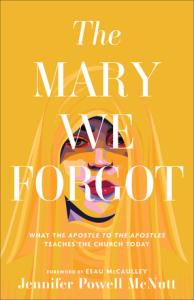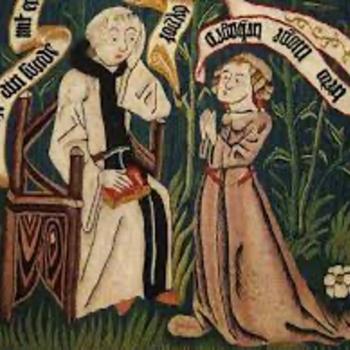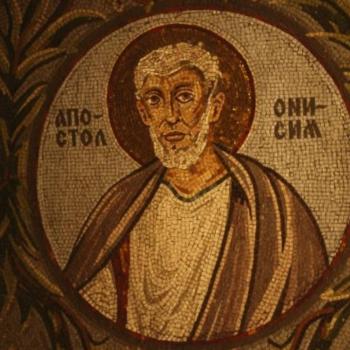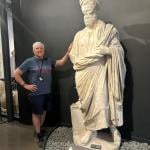For me, the days off around the holidays traditionally include many things: more baked goods than wisdom says should be consumed, football, family time, and books. This year, one of those books was Jennifer Powell McNutt’s The Mary We Forgot: What the Apostle to the Apostles Teaches the Church Today. Released this fall, McNutt’s book is a beautiful mix of theological reflections, Scripture analysis and exegesis, history, and pastoral musings. She seeks, like someone restoring a painting, to uncover a truer, Scriptural vision of Mary Magdalene from the layers of dust, varnish, and edits of other authors that have distorted our understanding of this important Biblical figure. A part of Jesus’s earthly ministry and the first witness to His resurrection, as McNutt shows throughout, Mary Magdalene has often been neglected, obscured, or misinterpreted in ways that hide important insights into Christ’s ministry, character, and the calling given to His followers.
I won’t try here to summarize McNutt’s narrative or give an overview of the full book; for that, you’ll want to read it for yourself! But as I read through her book, I couldn’t help but think about another text on Mary Magdalene that I teach in one of my classes: the medieval play The Digby Mary Magdalene. The play, surviving only in a single copy, came from East Anglia, the southeast part of England where much of the surviving medieval dramas from England were produced. In this region, Mary Magdalene was certainly remembered; as Theresa Coletti’s introduction to the Digby play notes, “Mary Magdalene appears regularly in major devotional, hagiographic, and other dramatic texts of East Anglian auspices. She numbers among the female saints most often represented on the painted rood screens that still embellish fifteenth-century East Anglian parish churches; she was a familiar dedicatee of those churches, the guilds that they supported, and other religious foundations in the region” (Coletti, editor, Digby Mary Magdalene, 1).
And the Mary remembered in this region and in this play connects in many ways to the Marys that McNutt traces out in her work: she is conflated with several other scriptural Marys and connected to the resurrection of Lazarus. She is purported to be from a wealthy family and associated with prostitution. The way in which Mary ends up in prostitution in the play is, in my opinion, one of the funniest parts of the text; she goes to a bar, has a drink, dances with a man, and is then suddenly a prostitute. As I joke to my students, fundamentalist nightmares about the dangers of drinking, dancing, and sex seem to be quite consistent across the centuries! More significantly, the Mary of the play follows the tradition of acting as an apostle, a missionary, and a miracle worker in her travels after the resurrection, with much of the latter part of the play taking place in France (as again explored by McNutt in Ch. 4 of her book). For my students (and probably for the medieval audiences from whom this play was written and performed), the play’s Mary Magdalene is hard to forget, surrounded in her play as she was by a zipline for Jesus (and angelic entrances), a collapsing temple, a shipwreck, and a burning entrance to hell. (For more on the staging of the play, see Matthew Evan Davis’ article).
While memorable, this play, as well as so many of the versions of Mary that McNutt explores in this book, obscure the life and witness of Mary as laid out in Scripture (for more on the real Mary, see especially Chapters 1, 2, 5, and 7 in McNutt’s book, along with her helpful tables that lay out connections between references in the Gospels). And I think that the way in which these retellings hide Mary is important for us to notice. Patristic authors, while less likely to associate Mary with prostitution than later authors, mixed many of the women in the Gospel accounts into a singular figure which they used to push against heresies that threatened Christ’s resurrection, divinity, or the Trinity (Ch. 2). Medieval authors, in line with medieval concerns about women’s bodies, clerical authority, and penitence, portrayed a Mary who was a penitent prostitute, both a warning to pursue purity and a model of penitence and divinely given authority (Ch. 3). While women writing during the Reformation emphasized Mary Magdalene’s divinely given authority as a teacher of the Gospel (pp. 90-94), male authors emphasized her lowliness as a woman as a tool used to highlight God’s power and the priesthood of all believers (pp. 84-89). Modern retellings are arguably even less accurate, with the recasting of Mary Magdalene as Jesus’s lover (whether real or hoped) in Jesus Christ Superstar or The Davinci Code. Even Dorothy Sayers, known for writing a beautiful summary of the significance of women in the Christian story, presented a composite Mary associated with prostitution– presented as “a dancing girl” to make her more appropriate for the children listening to the radio (p. 83). McNutt shows beautifully how these interpretations came to be, whether through tradition or apocryphal texts or tussles over relics. But why the variety of interpretations?
I brought my own background of research on dance and other issues marginalized in formal theological writings with outsized impact on the church to my engagement with McNutt’s book, and I think that in a lot of ways, Mary Magdalene’s story has much in common with the story of dance and the church. Because dance is pushed to the margins of theological discourse, most do not take the time to examine the pile of assumptions (drawn from culture, from theological concerns of each era, or from confusion) that accrue around it. Taking the time to deeply examine each era’s representation of dance shows what each era of church history found most significant: separating Christian worship from the worship of other religions in late antiquity, or preventing sacrilege by reforming clergy and protecting sacred spaces from physically dangerous bodies in the Middle Ages, or protecting sexual purity in young men by removing women from sight and mind from the Reformations onward. Dance is simply the mirror used to show the concerns of the clerics and authors of the day, and what Scripture has to say about dance itself is hidden under layers of cultural varnish. Similarly, Mary Magdalene, despite her prominence as a saint in certain traditions and periods of church history, has been marginalized in most formal theological analyses, a footnote to the men of the Gospels in many church writings and teachings. Because of this, assumptions have accumulated around her, making her a similar mirror that shows us where we’ve placed our theological concerns and fears during each era.
Yet as McNutt shows, this is not what Mary Magdalene was meant to be. Her careful unpacking of Scripture uncovers not a mirror, but a tower meant to point us to Christ. McNutt explains early in her book that Mary Magdalene, as some scholars have pointed out, might connect Mary not just to a place but also to an honorific; Magdala might be both a reference to a town on the west shore of Galilee and to the Aramaic word ‘Magdala,’ meaning ‘tower’ (pp. 14-16). The modern church might not often acknowledge Mary as a tower of faith, but past theologians like Jerome and Martin Luther did (pp. 16-17). Mary Magdalene as a mirror of the brokenness of the church, as cultural concerns often hide the calling to go and bear witness, is often disheartening for us to encounter. But Mary Magdalene as a tower is an encouragement to all of us, women and men. Mary Magdalene, the tower of faith, reveals that God uses all to spread His word. Mary Magdalene, the tower of faith, shows that despite distortion, God’s word and faithfulness has always been there. In teaching us more about this Magdalene, the one that Scripture shows us, McNutt helps to point us all to the encouragement found in her life and in her witness.














